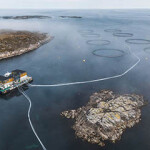Marine protected area effectiveness debated as UN high seas treaty advances
Marine protected areas on the high seas could be on the horizon because of an in-progress United Nations treaty for marine life outside national waters. But are MPAs actually effective?
The common view is that MPAs effectively preserve biodiversity in the oceans, and it’s well-established that they benefit fish and other marine life within their boundaries. What’s not as firmly known is what impact MPAs have beyond their borders.
The question of MPA effectiveness is complicated by the fact that there are so many types of MPAs, and each is designed and regulated differently.
“The strictest MPAs, marine reserves or no-take areas, can be quite effective at restoring fish populations in places where there has been substantial overfishing,” Linwood Pendleton, the global lead for ocean science at the World Wildlife Fund, told SeafoodSource.
At the same time, “There is such an enormous diversity of MPAs – and the level and kinds of protection provided – that it is impossible to talk about MPA effectiveness overall. Some MPAs are highly effective, others are not,” he added. “MPAs only work if they are well-staff and enforced.”
Many in the seafood industry are also irked by what they interpret as an arbitrary MPA design process. MPAs, according to National Fisheries Institute spokesperson Gavin Gibbons, constitute passive fisheries management. Too often they don’t rely on the best science, and they don’t mimic fishery management methods that have been shown to work, he said.
“Simply drawing lines on a map and saying ‘Don’t fish here’ is not the kind active, science-based stock-related fisheries management that is a hallmark of the best-managed fisheries in the world,” Gibbons told SeafoodSource. “They need to be part of a science-based effort that involves stock assessment work and a deep examination of the actual impact and benefit to the target fish population.”
It’s one thing to set aside certain areas for the maintenance of biodiversity, such as a seagrass beds, or to protect sensitive archaeological sites, Gibbons said. But arbitrary boundaries don’t make sense. Long-term sustainability, after all, must take into account the environmental, economic and social aspects.
“No one in the seafood community and no credible voice in the marine research world would support drawing lines on a map and saying ‘Don’t fish here’ without a robust examination of the impacts and effects of that decision,” Gibbons said. “Science, not sharpies, should lead the way in this discussion.”
Pendleton, the WWF scientist, said that most people agree that MPAs are not the be-all, end-all for marine conservation. Instead, MPAs need to be part of the mix. Good regulations governing fishing, pollution, and other activities outside protected areas are also needed, Pendleton said. A collaborative design process also increases the odds of success, according to Pendleton.
“I think most agree that MPAs work best when you involve the people that are most affected,” he said.
Pendleton said the key differentiator between effective and ineffective MPAs lies in resources.
“Too many MPAs are simply lines on a map,” Pendleton said.
This summer, Pendleton helped with the publication of special issue of the International Council for Exploration of the Sea’s Journal of Marine Science that compiles the views of a diverse set of scholars about MPAs.
There are already more than 11,000 MPAs and the number is rising, as countries seek to meet the Convention on Biological Diversity’s Aichi Target 11 calls for countries to have 10 percent of their exclusive economic zones in protected areas by 2020.
Ray Hilborn, a professor at the University of Washington, argues that MPAs don’t combat many of the threats in the ocean, including oil spills, energy production, plastic pollution, and other garbage. Additionally, MPAs aren’t the answer to overfishing because they only work to reduce it when fishing pressure is very high and stocks are seriously overexploited.
“MPAs and area closures in general do not reduce fishing effort, they only move it elsewhere,” Hilborn wrote in the ICES Journal of Marine Science special issue.
Meanwhile, most MPAs are also plagued by poaching and inadequate management capacity, wrote Brock Bergseth, a scholar at the James Cook University in Australia, who published a study that found the amount of discarded fishing gear was the same in fished and non-fished areas of the Great Barrier Reef Marine Park.
To reduce poaching and increase compliance with MPA rules, new management techniques are needed, Bergseth wrote in the journal. That might be social pressure from leaders in the fishing community, better messaging about ocean stewardship, or something else altogether.
MPAs also run into problems when there’s an incentive to make objectives and standards vague, to insulate them from criticism if they don’t perform well, according to Tundi Agardy, the director of coastal and marine initiative at Forest Trends, and the founder of the conservation group Sound Seas.
“So while no-take reserves can indeed be effective in protecting benthic habitat from physical destruction or preventing resource overexploitation, their overall impact is limited,” Agardy wrote in the journal. “It is easy to boast of marine protection when none exists – but allocating scarce management resources to remote places to create the illusion of protection is inefficient and deceptive.”






Share